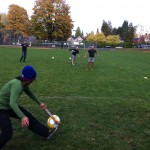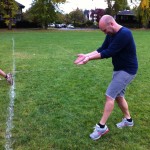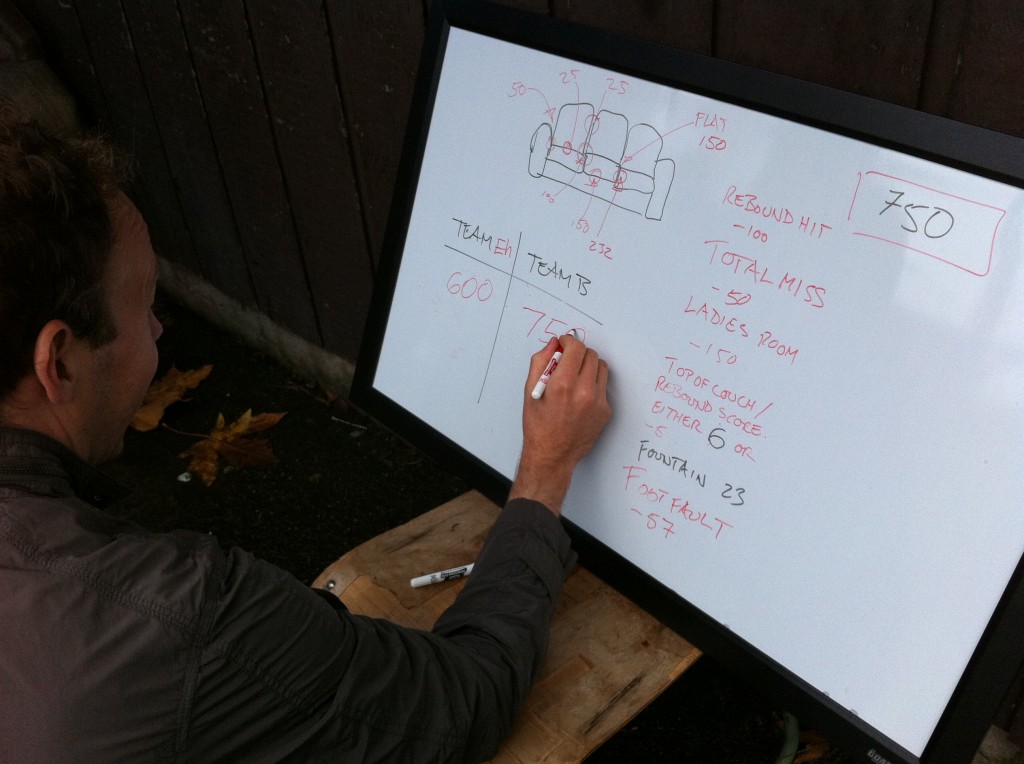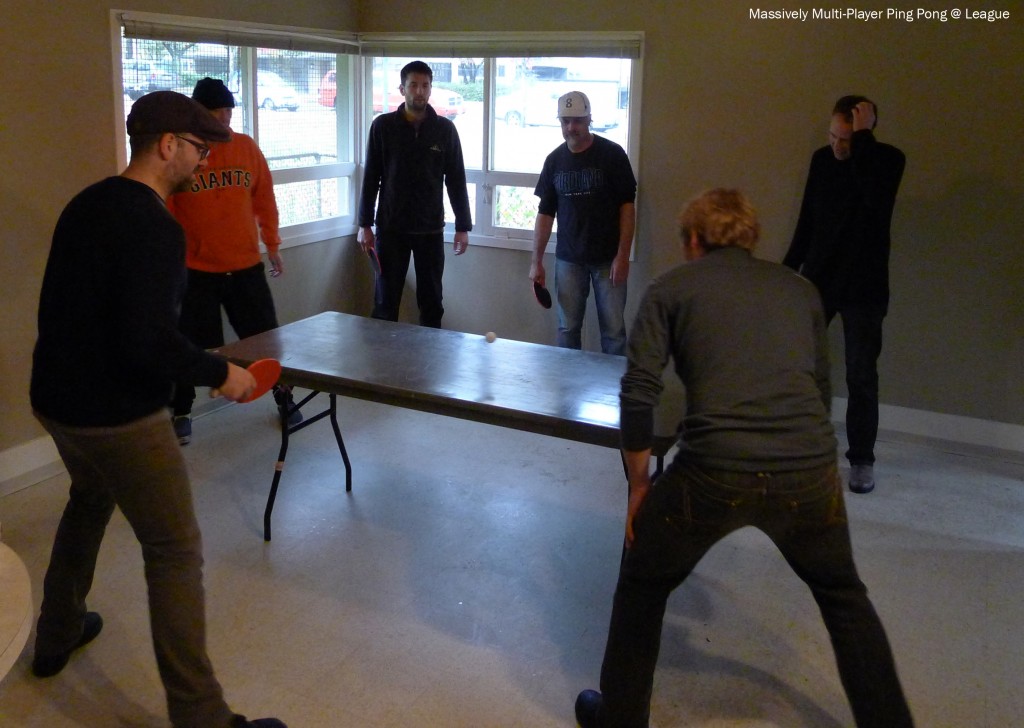A roundup of interesting projects and issues that recently crossed our desk. 1. Below the Belt from Vimeo user jiann Below The Belt is an interactive installation exploring the tensions between competitive contact sports and the inward focus of breathing
Played: Sunday 28 October 2012
Gölstrom
A new game that organically emerged from goofing around with the equipment at hand, as we realized that everyone was up for some fairly physical play. It was very fun and natural and completely unrelated to the games that were vaguely planned. Brave soul award goes to Bill (age 73-and-a-half), who was just walking by and gamely joined in.
The basics:
A line of diverse equipment is laid out some distance from a goal. Gölstrom is a game for a flexible number of people. In each round, the players shoot the equipment at the goalie, in whatever order they want, repeating until all the equipment has been shot. The equipment must be more or less delivered as it is commonly used (a dodgeball thrown, a tennis ball struck, etc.). The goalie is the one who scores points, for pieces that are stopped or miss the net. Two lines, closer and farther, mark the limits for shooting slower and faster-moving equipment. The way we played, all players took turns in goal, but it could also be played team vs team.
Emergent strategy:
Strategies of rushing the goal in waves are definitely useful, and of moving the goalie from side to side.
Modifications:
- A “Perfect Strom” is when you score on all of your shots in a round. A Perfect Strom is worth an extra point to the shooter.
- Conversely, if you are shut out on all your shots, you must shake the goalie’s hand and back away performing acts of supplication.
- Non-standard equipment can be used. Late in our game, a fallen maple-tree branch was added as a bat.
Upcoming League play – 28 October
League play
Sunday 28 October
12:00-4:00
Elm Park, Kerrisdale
League is an open gathering for the purpose of playing games and sports invented by community members. Each game, its playing field and its strategies will evolve through trial and improvisation, and new and unusual equipment may be invented. You are welcome to drop in; bring both body and mind.
Larger gatherings are held on the last Sunday of the month. For this one, some possible games include: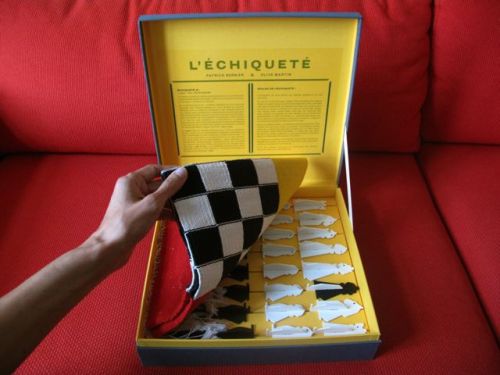
- Checkered Chess, a project by Patrick Bernier and Olive Martin
- Doubleball, the traditional aboriginal game
- Former Vancouver Poet Laureate Brad Cran’s tennis-soccer mod
Played: Sunday 14 October 2012
Notes from kickoff day, a rainy Sunday, October 14.
After realizing that the borrowed couch wouldn’t fit through the field house door, we strung up a tarp outdoors and tried three different activities: Couchie, Monkeying Around Training Program, and Massively Multi-Player Ping Pong.
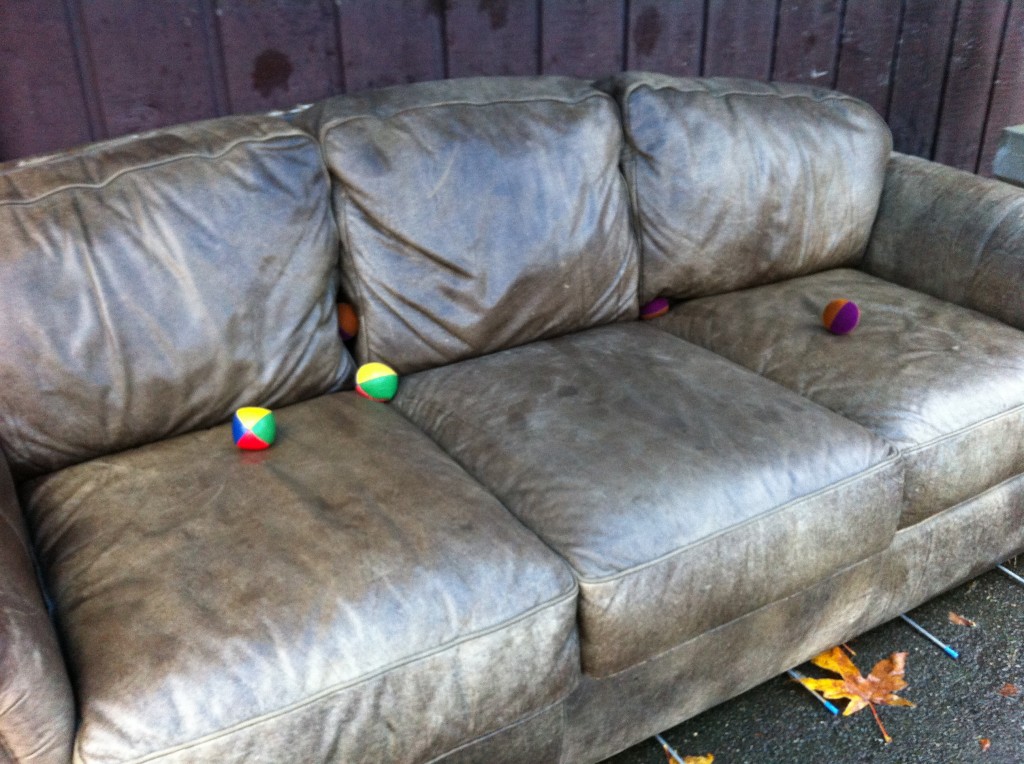 1. Couchie
1. Couchie
Cedric Bomford, Mike Love and Verena Kaminiarz introduced us to Couchie, a game invented in Cedric and Mike’s apartment in college years.
Basic description:
 Players take turns hurling beanbag juggling balls into an overstuffed couch, attempting to lodge them in the cracks. Different cracks are worth different points, depending on the difficulty, with the small vertical crack between the front cushions worth the most. Points are lost for missing the couch completely or stepping over the line. First team to break 750 points wins.
Players take turns hurling beanbag juggling balls into an overstuffed couch, attempting to lodge them in the cracks. Different cracks are worth different points, depending on the difficulty, with the small vertical crack between the front cushions worth the most. Points are lost for missing the couch completely or stepping over the line. First team to break 750 points wins.
Modifications made:
- When played in teams, one player from each team take turns pitching their team’s three balls, then you move on to the next matchup. Trade balls with each matchup.
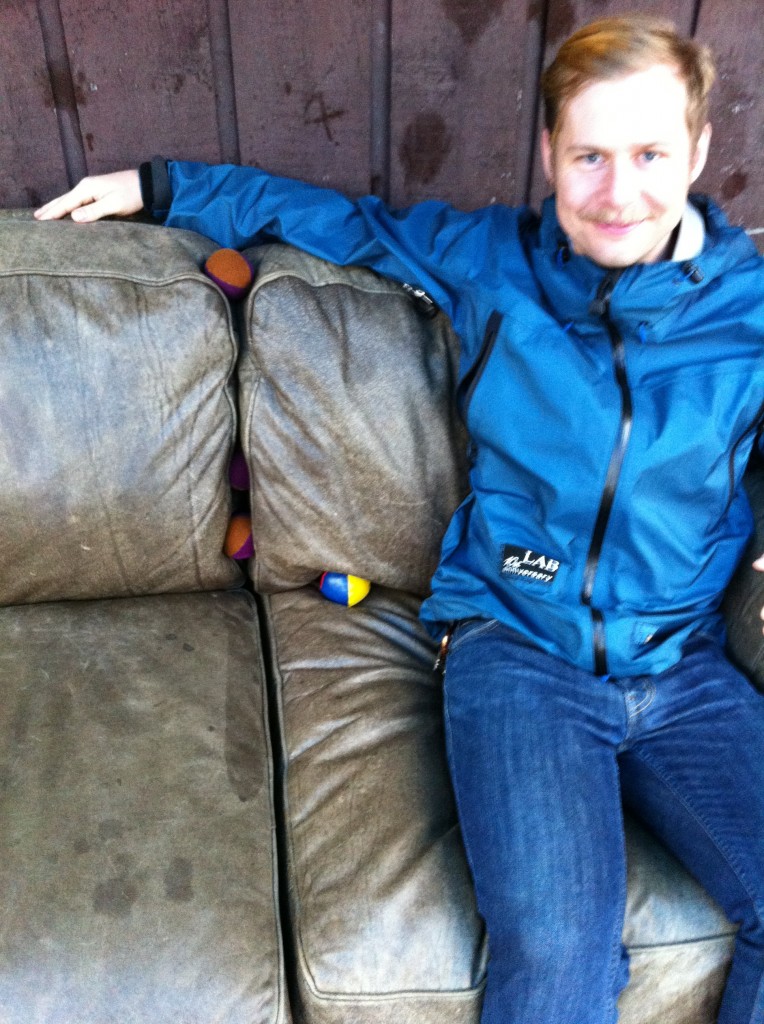 A small number of points were given for hitting the back wall and landing in the crack between frame and back cushions.
A small number of points were given for hitting the back wall and landing in the crack between frame and back cushions.- Large penalty added for completely missing couch and landing the ball in the washroom.
- Clarified that you cannot touch in front of the line, even if the ball is released before you land.
- Extra points for stacking all three of one’s balls in a single vertical crack (aka Orion’s Belt).
Observations:
- Consensus amongst first-time players: much more fun than expected.
- There seem to be skills that can be perfected. Mike, the historic champion, was by far the highest scorer.
- Both a light touch and power seem to be viable techniques.
2. Monkeying Around Training Program
Rob Larson brought an idea about an open-source exercise activity that could be done anywhere in public: Monkeying Around. The idea, somewhat related to parkour, is that we should feel free to move playfully and in ways that don’t have to follow routines, and that the repertoire might grow as users add movements. It borrowed from capoeira some movements, the surrounding circle, and some rhythmic elements and sounds. Rob had us bounce like monkeys and crab- and bear-walk on all fours, first moving on our own, then facing off by pairs in the middle of a circle.
Feedback:
- There were some inhibitions to get over, partly because of unfamiliar movements, partly from feeling self-conscious about being in the centre of the circle.
- Could be interesting to have people move in ways related to different animals, kind of like different styles of martial arts.
- One way to get people out of their shells could be to have a goal of some sort.
- To be workshopped some more.
3. Massively Multi-Player Ping Pong
Nat Bailey introduced us to a game he’s used as a game-design exercise: Massively Multi-Player Ping Pong (MMPPP).
Basic description:
This is a game for as many people as you have paddles. Players are numbered, and play in order. The table is a ping-pong table without the net, or any other kind of table. Each shot must hit the table three or more times then once on the floor (rolling on the table counts as infinite bounces). If the next person doesn’t make their shot, the last person to make a successful shot gets a point.
Modifications/precisions:
- No penalty for not making a shot; serve just passes the the next person.
- Walls and other surfaces are in play.
Observations:
- The number of people changes the game quite a bit. With more people, inattention and crowding become issues.
- Playing order makes a difference.
- Good positioning seems to be to set up across the table from the person playing, but guile can be a factor.
Press: Georgia Straight, “Vancouver artist Germaine Koh asks public to help invent new sports”
The Georgia Straight
Vancouver artist Germaine Koh asks public to help invent new sports
By Stephen Thomson, October 12, 2012
 Germaine Koh wants to bring fun and games to a small park in Vancouver.
Germaine Koh wants to bring fun and games to a small park in Vancouver.
The local artist is behind the new “League” project, a free drop-in program that gives people a forum to play games and sports they have invented together.
The gatherings will be held weekly at the field house in Elm Park in Vancouver’s Kerrisdale neighbourhood.
“It’s a project that I’ve wanted to do for a while. I sort of proposed it in gallery situations when I’ve had exhibitions and we’ve never been able to pull it off,” Koh told the Straight by phone today (October 12).
“I’m quite interested in creating situations that bring people together in kind of open-ended, experimental ways,” she said.[...]
Koh described League as experiment to get people thinking creatively. She said its success will rely on public participation.
“It’s a kind of proposition about that we could be more playful in our everyday lives and that we could look at a lot of different situations in a playful way,” she said.
[...link to full article]
From the vault: “Checks and Balances” from Art Lies
When discussing play and art, I was reminded of this piece I was challenged to write four years ago for the art journal Art Lies. The theme of the edition, guest-edited by the curator Stuart Horodner, was “second acts” — the myriad other things cultural producers do to the side of their practices, and Stuart asked me to write about playing roller derby.
Although that sport has developed and changed a lot in four years (my current teammates would scoff at any resemblance to burlesque and we’re dropping our aliases, as the sport has become ever more, well, athletic), the words I wrote about how sport complements my activities as an artist still hold.
Click the title for the full article. Excerpts:
Checks and Balances
Germaine Koh
Art Lies no. 61 (Spring 2009), pp. 22-23As an artist, almost everything I do contributes to the “brand” associated with my name, but when I’m playing roller derby I’m known only as PLAYER 1.[...]
[O]f the sports I could choose to take up at the age of 41, roller derby aligns well with some of the principles of my work and public persona. Unlike most sports, it embraces social complexities, combining athletics and burlesque, aggression and caring, all with political self-awareness of these implications. It’s tied to music, street and grassroots cultures, and this authenticity is a big part of its growing underground appeal.[...]
I am obsessed with derby because it is a completely new activity unlike anything I’ve done before, and a genuinely challenging sport with a whole new-to-me set of rules, conventions and skills to master. These reasons also happen to reveal some basic principles of my work.
For me, art is a means of engaging with the world with the intention of contributing something original to the public exchange of ideas. The task I set for myself as an artist is to observe myriad patterns in the world and synthesize them into unexpected propositions that encourage us to reflect upon the systems around us. At a basic level, doing a wide variety of things and being in contact with people from many backgrounds makes me more culturally literate and agile—a more able and balanced observer and thinker. Although this is probably a truism, it also feels true in practice. Being involved in a lot of different activities and operating systems gives me insight into a wider range of phenomena, allowing me to think more subtly and opening up ever more fields of enquiry.
On one level, then, derby is just the latest of the many “other things” that I have thrown myself into for the simple joy of learning, experiencing something new, knowing more about the world and feeding a curious mind. But more specifically, the other things I do have always included sports. Competitive sport has helped make me a relatively well-rounded person. For the younger me, it was a toss-up between art school and finding a career in sport, and I was certainly the only art student playing on a varsity team at my university. Art finally prevailed when I realized that I could justifiably do all kinds of other things, including sports, under the umbrella of being an artist.
Except in a couple of instances, sport doesn’t figure literally in my art, but it’s there everywhere. A sense of competition is related to the standard of minimalism and conceptual elegance to which I hold my work. A feeling for emergent play and the organization of games helps me evaluate how audiences will interact with my work. The ability to concentrate while in a state of uncertainty allows me to conceive of lifelong projects and to have the faith to design others with open-ended outcomes. Being accustomed to playing within rules gives me a greater understanding of the innumerable conventions that I need to negotiate, and of course, the habits of teamwork are directly transferable to the collaborative aspects of my—and many other—disciplines.
Certainly, some aspects of organized sports are quite different than artmaking: it is often authoritarian, it requires adherence to immovable rules and uses set plays, and the goal-oriented nature of competition doesn’t lend itself to nuanced debate. Yet, other elements of athletics do encourage the types of rigor that serve artists well: strategy, focus, flow, tenacity, awareness and commitment are all ultimately developed through physical training. In other words, submission to a training regime is eventually good for freethinking too: a healthy body is more likely to house a healthy mind.
Sport also has the amazing effect of quieting the overly busy mind.[...] It’s primal, primary experience.[...] Sports let me reconnect with the delights of play and of really feeling stuff in the moment. The reckless way I play means that my career in roller derby is likely to be short-lived, but for now it complements, nourishes and provides a welcome counterpoint to the weight of my job.
[...]Vancouver, November 2008
News release
News release
9 October 2012, Vancouver
Artist Germaine Koh launches “League” for invented sports and games in Elm Park
- Who: Germaine Koh, artist in Vancouver Park Board Field House Studio Residency Project
- What: “League”, a new group for playing invented sports and games
- Where: Elm Park, 5800 Elm Street at West 41st Avenue, Vancouver, BC
- When: Tuesday afternoons and last Sunday each month (28 October, 25 November…)
As one of seven new residencies in the Vancouver Park Board Field House Studio Residency Project, artist Germaine Koh is launching the new community-based project “League” at Elm Park in Vancouver-Kerrisdale. League will be an open weekly gathering for the purpose of playing sports and games invented by members of the community. Each game, its playing field and its strategies will evolve through trial and improvisation, and new and unusual equipment may be invented.
For two years beginning October 2012, Germaine Koh will be using the field house in Elm Park, located at 41 Avenue and Elm Street in Kerrisdale, as home base for the League project and a studio for her art practice. Everyone is welcome to drop in to participate or propose a game for the group to try. League will be meeting in the park weekly (Tuesday afternoons 3pm to dusk until further notice) to workshop new sports and games, and organizing larger weekend events once a month, some with special guests from the worlds of sport, art and games. The first large event will take place on Sunday 28 October beginning at noon. The project blog at http://league-league.org hosts a schedule, discussion, research on play and games, and League documentation.
League is conceived as a project that will inspire city residents of diverse backgrounds and generations to come together to play, to think imaginatively, and to act collaboratively in response to the challenges posed by different game situations. All are welcome, whether they identify as athletes, creative people, both — or neither. The project is based in a belief that play is an essential human tendency that is related on one hand to problem-solving and negotiation skills and on another to a pure pursuit of joy. League participants will be encouraged to tweak typical game structures, to bring into play unexpected objects, to think widely about possible spaces for play, to pursue unconventional approaches to sport, and to tackle situations with both mind and body.
Germaine Koh, recipient of the 2010 VIVA Award for mid-career artists, is an internationally active Vancouver-based artist who works in many media, including interactive electronic installations, long-term process-based projects, and ephemeral situations in public space. She is known for artwork that examines under-valued aspects of daily life — for example the life-long project Knitwork, an ever-growing blanket knit from unraveled used garments, and the installation Fallow, in which she transplanted a vacant lot into an art gallery. Koh also has a long background in sport, currently playing roller derby for the All-Stars team that represents Vancouver’s Terminal City Rollergirls in inter-league play. League is the latest of many projects by Koh that focus on play or social interaction and shift habitual patterns of behaviour.
The Vancouver Park Board Field House Studio Residency Project was expanded this fall to encompass nine previously-vacant field houses in city parks. According to the City of Vancouver news release, artists for each field house were selected from more than 50 applications in response to a public call for proposals. The Park Board is providing use of the studio spaces in exchange for community arts based engagement. “The studio residencies will enhance the Park Board’s arts policy objective of arts in everyday life and contribute to addressing the City of Vancouver cultural plan priority of neighbourhood arts and the objective of supporting more creative spaces for artists.” For more information on the Field House Residency Project, contact the Vancouver Board of Parks and Recreation.
Links:
- League blog: http://league-league.org
- League on Facebook: http://facebook.com/LeagueVan
- League Twitter feed: http://twitter.com/LeagueVan
- Reference website for Germaine Koh’s artwork: http://germainekoh.com
- City of Vancouver news release about Park board field house studios: http://vancouver.ca/news-calendar/artist-studio-residencies-in-park-board-field-houses.aspx
Contacts:
- League project: Germaine Koh, league [at] germainekoh [dot] com
- Vancouver Park Board Field House Studio Residency Project: Daria Wojnarski, Communications Coordinator, tel. (604) 257-8440, daria.wojnarski [at] vancouver [dot] ca.
Games and critical invention
“What do you mean by invented sports and games,” you may ask. My own view is that play is at heart about invention, testing, and improvisation — potentially radical processes which can be lost when games become very regulated.
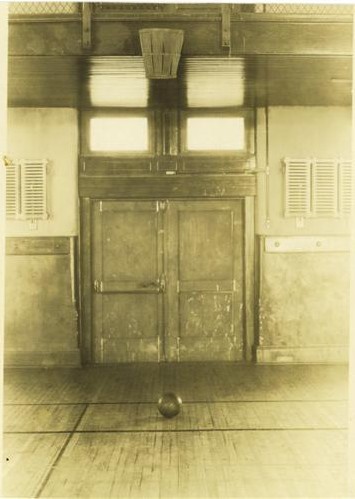 We might forget sometimes that even our best-known games and sports have not always existed the way they are now; they either evolved over time or through cultural exchange, or they were created wholesale. Basketball, a sport now played by 200 million worldwide, was invented in late 1891 by James Naismith as a challenge from the YMCA Training School in Springfield, Massachusetts, to create a sport for the school’s most incorrigible students that would be “interesting, easy to learn, and easy to play in the winter and by artificial light.”[1]
We might forget sometimes that even our best-known games and sports have not always existed the way they are now; they either evolved over time or through cultural exchange, or they were created wholesale. Basketball, a sport now played by 200 million worldwide, was invented in late 1891 by James Naismith as a challenge from the YMCA Training School in Springfield, Massachusetts, to create a sport for the school’s most incorrigible students that would be “interesting, easy to learn, and easy to play in the winter and by artificial light.”[1]
Game design and sports have also become big business, so it can be easy to overlook the critical potential of play. Theorists of play have defined it variously as an activity that stands apart from ordinary life, as activity that involves the free acceptance of binding rules, as a cultural expression of a society, and so on. Games always seem to emerge in relation to a system, and so it follows that play can be a potential tool for subverting expectations and conventions. Artists have understood this well, and over the years have invented many games
that involve a radical rethinking of existing systems.
Some critical games
- Anti-Monopoly. In 1974 economics professor Ralph Anspach invented a board game resembling Monopoly, but re-written with language that undermined the cultural idea of monopoly upon which the original was based. Similarly, Bertel Ollman’s 1978 game Class Struggle, reworked the original, proposing instead to help players “prepare for life in capitalist America.”[2]
 Cadavre Exquis (Exquisite Corpse). Invented (or re-imagined) by the Surrealist group around the 1920s, Cadavre Exquis was first a language-based parlour game in which different people wrote elements of a sentence without seeing the other participants’ contributions. The first sentence produced —”The exquisite corpse will drink the new wine.”— gave the game its name. Later it evolved into a drawing game. Like many Surrealist techniques such as automatic writing and collage, the game attempts to disrupt traditional patterns and conventional thoughts about authorship.
Cadavre Exquis (Exquisite Corpse). Invented (or re-imagined) by the Surrealist group around the 1920s, Cadavre Exquis was first a language-based parlour game in which different people wrote elements of a sentence without seeing the other participants’ contributions. The first sentence produced —”The exquisite corpse will drink the new wine.”— gave the game its name. Later it evolved into a drawing game. Like many Surrealist techniques such as automatic writing and collage, the game attempts to disrupt traditional patterns and conventional thoughts about authorship.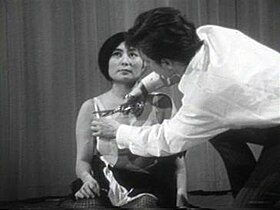 Yoko Ono. The Fluxus group with which Ono was associated, created many critical games that played with rules and chance operations. Although not obviously games, Ono’s work is particularly devastating when thought of in those terms, for they directly address the implicit rules by which we interact with each other. Take for example, her 1964 performance piece, Cut Piece, in which the audience was invited to the stage one by one to cut off and keep a piece of her clothing. She also made an all-white chess set (1966) and a series of works consisting simply of plain but socially challenging instructions, such as “Touch each other” or “Scream. 1. against the wind 2. against the wall 3. against the sky.”
Yoko Ono. The Fluxus group with which Ono was associated, created many critical games that played with rules and chance operations. Although not obviously games, Ono’s work is particularly devastating when thought of in those terms, for they directly address the implicit rules by which we interact with each other. Take for example, her 1964 performance piece, Cut Piece, in which the audience was invited to the stage one by one to cut off and keep a piece of her clothing. She also made an all-white chess set (1966) and a series of works consisting simply of plain but socially challenging instructions, such as “Touch each other” or “Scream. 1. against the wind 2. against the wall 3. against the sky.” Gustavo Artigas, The Rules of the Game, San Diego/Tijuana, 2000-01. A project for the cross-border project insite, it included an event in which two Mexican football teams and two American basketball teams played against each other on the same court at the same time. Although not the first artist to propose a game involving two balls (see Uri Tzaig, for example), the literal clash of cultures staged by Artigas brought to the fore questions of cultural habits embedded in games.
Gustavo Artigas, The Rules of the Game, San Diego/Tijuana, 2000-01. A project for the cross-border project insite, it included an event in which two Mexican football teams and two American basketball teams played against each other on the same court at the same time. Although not the first artist to propose a game involving two balls (see Uri Tzaig, for example), the literal clash of cultures staged by Artigas brought to the fore questions of cultural habits embedded in games. Lee Walton has created many performances that cross the systems of sport with urban systems and spaces, turning the city into a space of play. For example, for City Golf (2002), a round of golf was played in the city of San Francisco as if the golf course were superimposed onto the city. The score for each hole required a (social) reward or penalty of different degree to be performed.
Lee Walton has created many performances that cross the systems of sport with urban systems and spaces, turning the city into a space of play. For example, for City Golf (2002), a round of golf was played in the city of San Francisco as if the golf course were superimposed onto the city. The score for each hole required a (social) reward or penalty of different degree to be performed. The Game at Hand, by Larry and Debby Kline (2002). A hand-made chess set in which one side features icons of American culture, and the other an indistinguishable set of burqa-clad figures. As the artists describe, “As viewers are encouraged to play, it becomes evident that the game cannot be conducted fairly even with the most conscientious of intentions. Once engaged, players become quickly confused; the player controlling the US side of the board cannot adequately strategize and the opponent will eventually violate the rules of the game either knowingly or unknowingly.“[3]
The Game at Hand, by Larry and Debby Kline (2002). A hand-made chess set in which one side features icons of American culture, and the other an indistinguishable set of burqa-clad figures. As the artists describe, “As viewers are encouraged to play, it becomes evident that the game cannot be conducted fairly even with the most conscientious of intentions. Once engaged, players become quickly confused; the player controlling the US side of the board cannot adequately strategize and the opponent will eventually violate the rules of the game either knowingly or unknowingly.“[3] Big Urban Game, by Katie Salen, Nick Fortuno and Frank Lantz (2003). The B.U.G. project was commissioned by the University of Minnesota Design Institute as part of a process of looking at urban planning for Minneapolis-Saint Paul. Three teams moved large, inflatable game pieces through the Twin Cities, taking advice online advice from the public to determine the fastest route. As Lantz writes about games that cover a large area, played by large numbers of people, set in the real world, they tend to “distort the relationship between game worlds and real worlds.”[4]
Big Urban Game, by Katie Salen, Nick Fortuno and Frank Lantz (2003). The B.U.G. project was commissioned by the University of Minnesota Design Institute as part of a process of looking at urban planning for Minneapolis-Saint Paul. Three teams moved large, inflatable game pieces through the Twin Cities, taking advice online advice from the public to determine the fastest route. As Lantz writes about games that cover a large area, played by large numbers of people, set in the real world, they tend to “distort the relationship between game worlds and real worlds.”[4]
Notes
- John Fox, The Ball: Discovering the Object of the Game (Harper Perennial, 2012), p. 267-8.
- Mary Flanagan, Critical Play: Radical Game Design (MIT Press, 2009), pp. 87-8.
- Larry and Debby Kline, “The Game at Hand,” http://www.jugglingklines.com/Game_at_Hand.htm.
- Frank Lantz, “Big Games”, http://www.decisionproblem.com/big/
City of Vancouver press release
City of Vancouver press release
More than 30 local artists set to work out of Park Board field houses
October 2 2012
More than 30 local artists, including internationally renowned visual artist Germaine Koh and composer/double bassist Mark Haney, have been selected to participate in the Vancouver Park Board’s artist studio residency project in seven locations.
“The arts are critical to a community’s quality of life,” says Park Board Chair Sarah Blyth. “The studio space will provide a supportive, creative environment where artists can develop their work, engage residents and increase participation in the arts.”
Germaine Koh, winner of the 2010 VIVA award, will use the Elm Park field house as the home base for the community-based project League. League will be a weekly gathering of people who come together to play sports and games invented by members of the public. Participants will attempt to play with the guidelines, equipment and spaces suggested, and will further adapt the game, evolve strategies, and invent new equipment through trial and improvisation.
Obscure sports — links
Miscellaneous links to obscure, oddball, and cult sports.
- How Stuff Works, “9 Odd Sporting Events from Around the World“: including Cheese Rolling, Pooh Sticks, and Wife Carrying.
- Listverse, “10 Odd Discontinued Olympic Sports“: in case you thought Tug-of-War was just for kids.
- Matador Network, “10 Odd Sports Around the World“. It’s official: everyone thinks Toe Wrestling is odd.
- The Rough Guide to Cult Sport (London: Rough Guides, 2011). Compendium of sports with dedicated followings, cult sporting figures, and historic battles. Get a taste of some on the Rough Guides site.
- Top End Sports, “Complete List of Weird and Unusual Sports” and “Unusual Sports“.
- World Alternative Games in Llanwrtyd Wells, Wales, best(?) known as the traditional home of the World Bog Snorkelling Championships.


